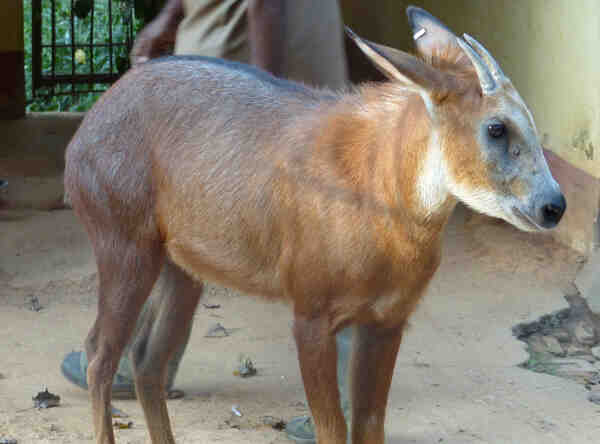Capricornis rubidus
IUCN
LCBasic Information
Scientific classification
- name:Capricornis rubidus
- Scientific Name:Capricornis rubidus,Capricornis sumatraensis Blyth, 1863 ssp. rubidus ,Red Serow,Burmese Red Serow,Arakan Serow , Roter Serau , Saro carmin, saro rouge , Sirao rojo,Serau rojo, serau de Birmania,Red S
- Outline:Ungulata
- Family:Artiodactyla Bovidae Serow
Vital signs
- length:140-155cm
- Weight:110-160kg
- lifetime:10-20years
Feature
Newly recorded mammal species in China
Distribution and Habitat
Distributed in hilly tropical forests in northeastern India (south of the Yarlung Zangbo River), Bangladesh (east of the Jumuna River), and northern Myanmar. In 2017, red serows were also found in the Gaoligongshan Nature Reserve in Yunnan Province, China.
Nothing is known about the natural history of the red serow. It is assumed that they are ecologically similar to the Chinese serow, inhabiting rugged and steep hills and rocky places, as well as hilly and mountainous forest areas with gentler terrain.
Appearance
The serow is 140-155 cm long, 85-95 cm tall at the shoulder, and 8-16 cm long tail; it weighs 110-160 kg. The fur is coarse and a distinctive reddish-brown color overall, with white underparts. There is a thin dark dorsal stripe that runs along the spine from the shoulder to the tail. The top of the neck has long bristles that may stand upright when excited. The cheeks are unmarked, but there are large infraorbital glands in front of the eyes. The white patch under the chin extends to the top of the throat to form a white bib. The ears are long and pointed. Both sexes have tapered, backward-curving horns that are 15-25 cm long, with males tending to have longer and thicker horns.
There are two forms of the serow: dark red and light red. The darker form has black base hair on the head, and the lighter form has lighter fur on the head from a white base. The darker form is sometimes called the "true" serow or Burmese serow, and the lighter form is called the "Assamese se
Details
Red Serow, with no subspecies, is a separate species of the genus Serow in the family Bovidae of the order Artiodactylus.

The red fur appearance of the Red Serow is easily distinguished from other black, gray or dark brown species of the genus Serow. However, some experts believe that the population of red serow living in India is actually a Himalayan serow; this has not been resolved. The smaller red serow (Naemorhedus baileyi) lives in the same area as the red serow, but is smaller and more compact. The horns of the serow are also smaller and the neck is not bristled.
The life habits of the red serow are not well understood, but are probably similar to other serow species. Most active in the morning, late afternoon or evening. Caves and cliffs serve as shelter. Serows are usually resident and do not migrate. The infraorbital glands may play a role in territory marking. When sounding the alarm, serows use loud whistles or snorts. Usually live alone or in small groups of 2-5. Diet is mainly grass, twigs and leaves.
The gestation period of the red serow is about 7 months, with one calf born per litter, and the weaning period of the young serow is about 5-6 months. Sexual maturity time: females are about 30 months, and males are about 30-36 months.
In Myanmar, red serows are hunted in large numbers, and the meat is usually eaten locally, but parts, including the front legs, head, horns and fat from the stomach, are the most popular traditional medicine. These parts are rendered to magnify their effects and sold in the form of small bottles of oil. According to dealers, this oil is used externally to treat skin diseases and joint problems. The horn tips are also exported from Myanmar to Thailand, attached to the claws of fighting cocks to become "spurs", which are believed to give them more strength.
Threats to the Serow are unknown, but other large mammals are hunted in large numbers in the region. Serow in Myanmar is one of the most traded species in the local trade. Serow was present in every market surveyed by TRAFFIC in Myanmar in 2006, and in most markets it was the most common species, with the majority of parts observed being the horns and head. Many of these markets were located on the Myanmar-Thailand border, and dealers claimed that all buyers in these border markets were from Thailand, demonstrating a blatant disregard for national legislation and CITES. Serow species are protected by law throughout Southeast Asia, but in many countries or regions, conservation of the species does not appear to be a priority at the regional level.
In 2006, interviews with dealers at border markets and markets in central Myanmar revealed a clear decline in Serow numbers in all areas surveyed. In many locations, they have become scarce.
Listed in the IUCN Red List of Threatened Species in 2008 ver3.1 - Near Threatened (NT).
Listed in the Washington Convention in 2010 Class I.
Protect wild animals and eliminate game.
Maintaining ecological balance is everyone's responsibility!








